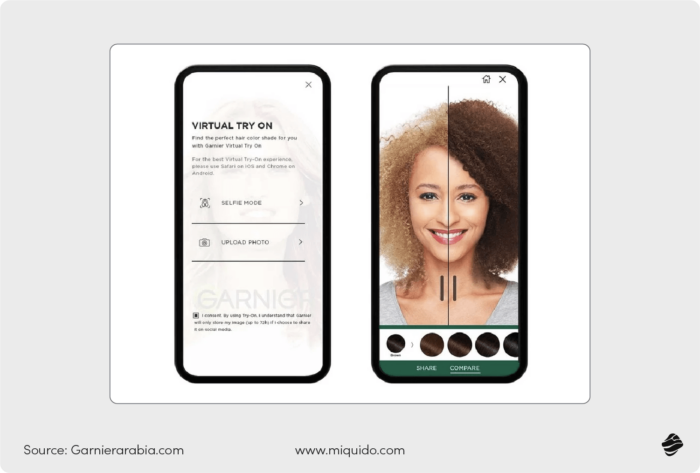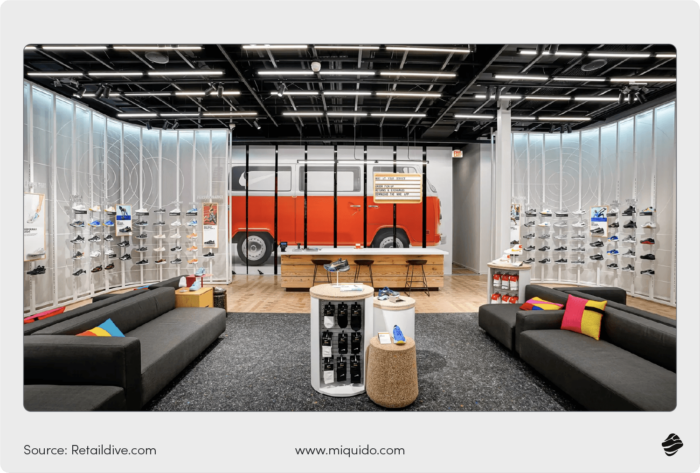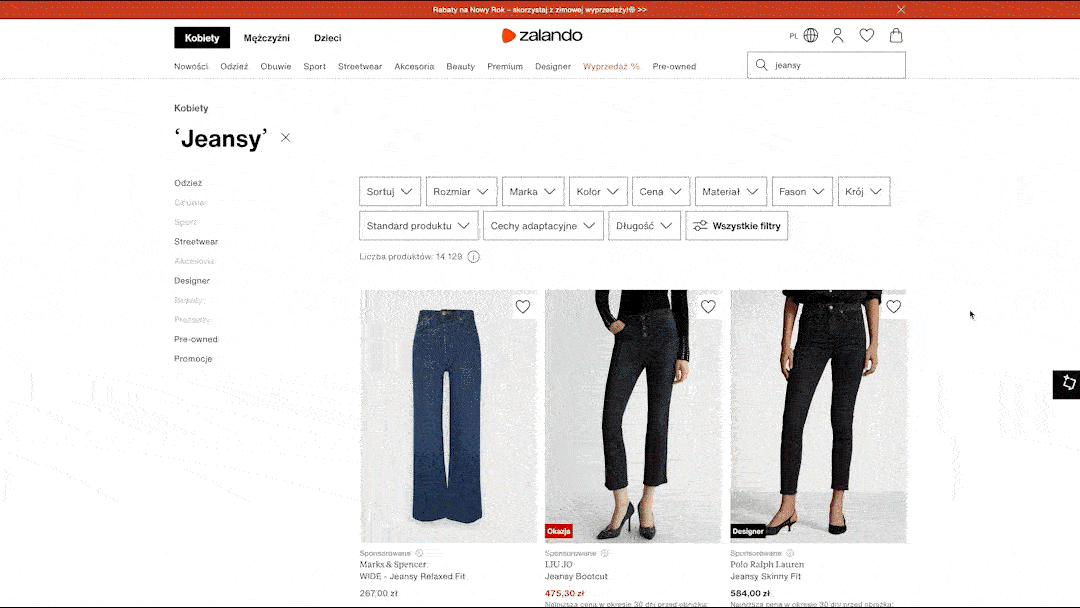A few years ago, the recipe for success in eCommerce software development was quite simple: a clear store, good SEO, and most importantly – competitive products. Today, with so many online stores and fierce competition, it’s not as easy to stand out and establish a strong position, and latest eCommerce trends reflect that.
The recipe for success? Some focus on price competition, while others prioritize the user experience. Implementing the latest eCommerce trends in your stores and setting new ones allows you to hit two targets with one arrow: attracting new customers and strengthening relationships with existing ones.
What are the main eCommerce trends for 2025? Which eCommerce app features will gain importance, and which may lose their impact? Play fortune teller with us and look into the future!
1. Immersive shopping through AR/VR and GenAI
In 2025, virtual reality and GenAI will undoubtedly set new directions for eCommerce. The adoption of these solutions hasn’t been as fast as predicted, but gradually, eCommerce companies have begun implementing them.
A prime example is virtual try-ons, which are now a standard in the fashion, beauty, and skincare industries. It’s important to implement this function well, as it can be very beneficial for marketing. Take a look at Warby Parker, the eyewear brand that introduced this feature for its customers in 2021.

L’Oreal GROUP has also been using such solutions in their brands, from Vichy to Garnier. The tool ModiFace, purchased by them in 2018, allows for adaptation to various functions, from testing hair color effects and makeup to preliminary skin assesment. The company is adapting AI for the purpose of its AI diagnostics tool based on image processing. Based on your selfie, the app will understand your skin’s needs and suggest the matching products.

Potential challenges? AR/VR experiences require real-time processing of large volumes of data, such as 3D images, customer preferences, and interactions. This can strain servers, lead to slow loading times, and require significant computational resources.
The next crucial issue is data privacy. AR/VR features often require access to sensitive device data, such as camera, microphone, and location. To prevent users from churning, you need clear and transparent consent processes. They should be aligned with local data processing users may hesitate to engage, and misuse of data could lead to privacy concerns, legal issues,

2. Virtual storefronts
Transferring the fitting room experience to the online space is a great way to boost sales, but it is not yet widely reflected in the ecommerce industry. In areas involving furniture, decor, and various utility and decorative items, brands can make use of virtual storefronts and augmented reality features.
This shift is becoming more relevant as mobile shopping continues to grow, allowing consumers to engage with products in more interactive ways. In the case of the IKEA app, it allows users to check in real-time how furniture will fit in a given space. Simply by turning on the camera in a room, the app automatically places 3D models of the selected furniture in the space, scaling them appropriately to reflect realistic dimensions.
By incorporating purchasing history AI, brands can further personalize recommendations, enhancing the overall shop online experience and fostering greater consumer engagement. A potential challenge? UX design in mobile commerce requires meticulous approach since small interfaces may cause challenges in navigating such complex features.

3. Hybrid shopping experience
In the last years, we could see many brands shift focus from online back to in-store. Nike’s strategy is a great example of how online and offline experiences can be seamlessly integrated to maximize profits. Their Nike Live stores blend physical retail with digital offerings, encouraging customers to use the Nike app for various purposes. They can scan items in-store for additional sizes or colors, reserve fitting rooms, and check out directly via their phones.

This approach not only creates a sense of novelty and earns the brand extra points for attracting customers with an engaging experience, but it also provides a valuable source of comprehensive data and a way to gather more. Nike benefits when users open the app, but they also gain something in return—through the app, customers have access to exclusive products and promotions in Nike Live stores.
4. Better AI avatars
Not long ago, humanoid robots and AI-generated avatars would send us straight into the uncanny valley. Today, distinguishing between an authentic image and one generated by AI often requires a trained eye.
This presents some risks, but today we’ll focus on the opportunities. Well-made avatars along with chatbots in eCommerce can bring huge operational benefits, automating parts of customer service, onboarding, and more.

When Samsung announced in 2020 that they were releasing the world’s first digital human, expectations were huge. A few years later, fresh off the wave of GenAI excitement, such images no longer make a huge impact—on a daily basis, on social media, we encounter more authentic avatars.
Technology has advanced, generating avatars is cheaper than ever, and we are starting to get used to them. These are the perfect conditions for this trend to make a comeback, especially in light of the increasing ecommerce spending and the rise in mobile commerce.
Key challenges? While GenAI is increasingly adept at mimicking fluid gestures, authentic emotions, and natural conversations, it still carries a certain generic quality. Creating an avatar that streamlines processes while also having a magnetic personality—that’s the ultimate ecommerce goal for 2025 and beyond.
By supporting personalized shopping experiences with AI avatars, brands can increase brand loyalty and foster deeper connections with their customers, helping to boost online sales, reduce customer support tickets and reslove poor customer service issue.
5. Dynamic website content
By 2025, online stores will still need to prioritize showcasing products, because in the end, that’s what matters most. However, brands that sell well know that the story and storytelling are just as important.
Dynamic elements on a website fit perfectly with this trend, drawing users into a journey and appealing to their emotions. And emotions sell—that’s no news. The key is to optimize them for mobile devices, since they are currently standing for the majority of global ecommerce sales.

Just look at fashion brands, especially in the prêt-à-porter sector. The online store of Polish designer Magda Butrym is largely made up of dynamic elements that catch the eye and beautifully highlight the spirit of the collection. Wearable products, in particular, benefit from such display techniques.

Popular brands like Zara also use these solutions, combining dynamic videos and integrated content from social media. The dynamic content like the room map above that transports you to the products in the catalogue
6. Interactive customization tools
Customization is the new norm today in online retail. Even ecommerce retailers that primarily offer fixed products are implementing customization options to give their online shoppers more agency. Ultimately, this strategy proves to be effective in driving ecommerce sales.
This is particularly common in the jewelry industry, where adapting products to customer requirements is relatively easy and cost-effective. Take Tiffany & Co., for example, which has perfected its customization system.
The footwear, apparel, and furniture industries are also increasingly offering product personalization, with great examples being Nike and Reebok. The key here is an efficient and well-designed configurator that aligns with ecommerce trends.
Using GenAI to generate 3D visualizations of the finished product and integrating the configurator with virtual try-ons is an approach that resonates with the growing demand for customization in the ecommerce industry.
Beyond enhancing the user experience, AI can also support cost and operational efficiency by validating designs for manufacturability in real-time, ensuring that the ecommerce spending is optimized.
Replicating the dynamics of social media in eCommerce and the growth of social commerce sales is now, for most ecommerce companies, an inevitable step. Even if they don’t sell directly through Instagram, they can enhance the user experience by integrating brand-related social media content into their online retail platforms.
For users, this can represent a sense of belonging—especially in the case of apparel brands—but also simply social proof. “Look,” says the brand, “others want to buy our products.” We’re being transparent—see how others capture them; they have no interest in beautifying reality. Or, “Look, our products are chosen by people you like and aspire to be like.”
This type of content integration helps ecommerce brands build trust and credibility, addressing most common customer complaints and enhancing customer satisfaction.

Companies like Zalando are incorporating elements of social media into their stores in interesting ways, weaving influencer styling into search results. Clearly outlined styling items with direct links to product pages make it easier for users to transition to online purchase.

8. Crypto payments
Cryptocurrencies have not dominated payments as some predicted, but they have definitely become more widespread among consumers. More and more ecommerce companies recognize this need and allow online shoppers to use this form of payment. A large part of this is dependent on B2B/B2C system providers, who do not ignore the importance of crypto.
Shopify is keeping up with the times, enabling merchants to accept crypto through integrations since 2022, and other eCommerce platforms may soon follow. Crypto is no longer the Wild West; it’s becoming a more regulated niche. This encourages ecommerce companies to take a step in that direction, increasing inclusivity and opening up to a potential niche of international customers.
How to do this wisely? Integration with trustworthy exchanges and AML measures are key. Mobile commerce app security gains even more importance when diverse payments come into play.
9. Subscription commerce
Do you remember that just fifteen years ago, subscriptions were a fairly controversial option? Few believed that consumers would want to commit to such arrangements for services like music or movies. Today, subscriptions are a common choice, from streaming to meal plans. In online retail, they are also becoming increasingly popular.
Niches focused on products that require regular consumption and benefit from consistency, like beauty products, can greatly benefit from subscriptions. Ipsy, Allure, Bombibox, Curology – all these ecommerce brands rely heavily on this sales model. AI in eCommerce enables a more proactive approach to its implementation: brands can track the progress of a customer’s regimen and, for example, suggest changes to their current skincare set.
Online retailers and ecommerce brands appreciate the continuity that a subscription provides, especially when it comes with unique offers and financial benefits. This model also serves as an excellent source of valuable data on consumer behavior, which can be used to optimize the product range and automate inventory management. By tapping into these insights, ecommerce companies can improve customer satisfaction and better align with ecommerce trends.
Include 2025 eCommerce trends in your solutions
Our experienced UX designers and developers will bring your vision to live, developing custom eCommerce solutions that pave the way for innovation in your industry. Implement 2025 emerging trends in your eCommerce solution, blending new features, influencer marketing strategies and hybrid customer experience.






![[header] what is quick commerce (q commerce)](https://www.miquido.com/wp-content/uploads/2022/09/header-what-is-quick-commerce-q-commerce-432x288.jpg)
![[header] case study enhancing mobile app performance and loyalty program efficiency in grocery retail](https://www.miquido.com/wp-content/uploads/2025/04/header-case-study_-enhancing-mobile-app-performance-and-loyalty-program-efficiency-in-grocery-retail-432x288.jpg)
